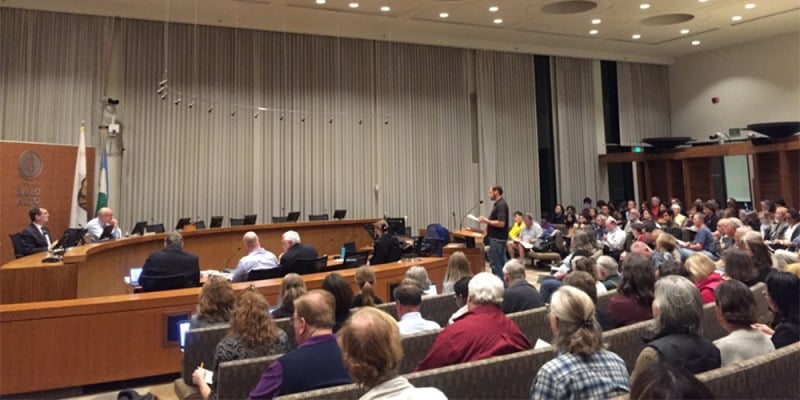The Palo Alto City Council voted unanimously on Monday to request that Stanford contribute up to $82.4 million over the next 17 years to the city’s affordable housing fund. The Council also plans to ask the University for funding for improvements to bike and pedestrian paths, flood risk reduction, parks maintenance and expansion of a shuttle system that supports a larger portion of the city.
The requests, which highlight concerns from Palo Alto residents and the affected school district, will be incorporated in a letter signed by the Mayor to the County Board of Supervisors. It is unclear when the letter will be delivered.
“It’s my belief that we should be broad, rather than limit our requests at this stage of the process,” said councilmember Alison Cormack.
The city’s demands are a part of ongoing negotiations over the General Use Permit (GUP), which will be subject to approval in June. The 17-year expansion plan would authorize Stanford to construct 3,150 new housing units for students, faculty and staff as well as 2.275 million square feet of academic buildings.
The Board of Supervisors, which will receive the Council’s letter, also has final jurisdiction on Stanford’s GUP application.
The proposed fees, which could add up to a $82.4 million contribution over 17 years, are intended to compensate housing-related impacts within the city’s “sphere of influence.” According to the letter from the Staff of Palo Alto, this area extends from El Camino Real to Junipero Serra Boulevard. The total cost comes from the “full build-out of the Stanford GUP [multiplied by] Palo Alto’s current housing impact fee,” said Jonathan Lait, the County’s Interim Planning Director, during the meeting.
However, Palo Alto Vice Mayor Adrian Fine said that development impact fees for the city “are [not] quite appropriate to charge on Stanford academic lands.” The Council should find an additional, more appropriate, justification for the total contribution requested, Fine said, considering that Stanford will already pay Santa Clara County a raised housing fee to support affordable housing in the area. In September 2018, the County’s Board of Supervisors decided to double the amount the University pays for each square foot of new nonresidential development it constructs, increasing the rate from $36.22 to $68.50. This new fee will go into effect on July 1, 2020.
Stanford’s current GUP includes 3,150 new on-campus housing units and student beds, in addition to $56 million for local affordable housing projects.
It is unclear how Stanford will respond to Palo Alto’s demands. In December, the University filed a lawsuit against the County’s “inclusionary housing” ordinance that requires the University to make 16 percent of its new housing units available at an affordable housing cost. Stanford argued that the ordinance unfairly targets the University. However, University spokesperson E.J. Miranda told The Daily that Stanford’s litigation challenging the County’s ordinance is “not related” to the University’s support for affordable housing.
“Stanford and Santa Clara County are now discussing affordable housing as part of a package of community benefits the university could provide through a development agreement,” Miranda wrote in an email to The Daily. “We look forward to continuing those discussions with the county.”
Palo Alto and Santa Clara County are not the only stakeholders requesting money from Stanford’s proposed expansion. Menlo Park and Mountain View have also asked for assurances from Stanford to fund improvements in areas affected by the University’s growth, and the Palo Alto Unified School District (PAUSD) considered legal action against Stanford for the negative impacts expansion would create.
Palo Alto Mayor Eric Filseth showed support for PAUSD, saying the school district’s appeal for “full mitigation” of Stanford’s impact should be included in the letter to the Board.
“Suppose Palo Alto didn’t exist — what would Stanford do … if they were to proceed with this expansion?” he said. “They would make an investment in their own school district. So, why would it not be appropriate to make an investment in the PAUSD?”
Filseth added that requesting Stanford “mitigate the traffic impact” of its expansion is an item that should be included in the letter to the Board. Councilmember Alison Cormack later said the University should consider expanding its Marguerite Shuttle service to the larger Palo Alto community.
“It’s a no-brainer to me in the traffic and transportation area,” she said.
Additional demands include requests for funds to redesign the city’s rail crossings, improvements to the Bol Park pathway connecting the campus and Stanford Research Park and for a crossing guard program to be implemented in areas most impacted by University traffic.
The city also requested a one million dollar contribution to design a new Downtown Coordinated Area Plan. The plan encompasses bridge alternatives at Palo Alto Avenue, a downtown Transit Center redesign to accommodate train electrification and other improvements for pedestrians and bicyclists in the downtown area.
While the Council voted unanimously in a motion to approve the letter’s contents, Filseth said he has low expectations for the level of influence the letter would have on the development agreement negotiations between the County and Stanford.
“The important thing is to get the main [substance] in here,” Filseth said. “This letter is going to go to the County, and the County may use it, or may not use it, or may not even read it, for all we know.”
Contact Alex Tsai at aotsai ‘at’ stanford.edu and Elena Shao at eshao98 ‘at’ stanford.edu.
